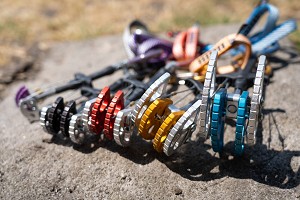
The original Camalots were some of the first camming devices on the market,
Feel, Handling and Placing
All the materials that have been used in the construction of the C4 feel solid, and have held up well to rough use so far. This isn't all that surprising given the C4's reputation as a solid, well-built unit. My old rack of C4s still have plenty life left in them after years and probably 1000 pitches of winter and summer climbing. Looking at this new version, and given what they've already been through this summer, I see no reason why the new version couldn't stand up to the same abuse.
Placing the C4 still has that typical reassuring Camalot feel, probably due to the strong camming springs and the generally solid feel of the entire unit. The feel of a cam is something quite personal and after climbing on Camalots for many years it's something I'm just very used to. These feel much the same as previous generations (aside from the weight!) and if you liked the old Camalots, chances are you will like their replacement.
Back Diamond have modified the pattern on the lobe face (the section of the lobe that contacts the rock). The old single indent texture is gone and now we have something a bit different - a sort of blocky zig zag block pattern. Trying to determine if this makes any sort of difference in a review is pretty much impossible. No difference to cam engagement was noticed and if I was to theorise if this makes any sort of difference I'd suspect it would be very minimal to no difference at all.
The stem of the cam is made up of variable stiffness plastic that is slightly stiffer depending on the weight of the lobes. This gives a consistent feel across all the sizes, preventing that floppy feel you find on some other large cams. A slight difference that I have noted with the new C4s is when it comes to placing them in horizontal breaks. The new stem seems to bend rather less uniformly, with most of the bending occurring where the thumbloop and the shaft meet. I put this down to the new plastic used in the construction of the shaft, something Kolin Powick talks about in the video below.
The other slight difference I've noticed is the general stiffer feel of the plastic. I'm comparing this to an older C4 that is seven years old, so the plastic protecting the shaft on that cam might now be slightly softened. Be that as it may, the new C4 definitely feels stiffer - something you particularly notice in the smaller sizes. While I've had no issue to date, it's conceivable that thanks to the stem flexing less the new C4 could be slightly more prone to walking. We've theorised that they were developed with America's straight, soaring cracks in mind, rather than the tricksy and wandering nature of a lot of UK trad.
Camming angle
The camming angle of the new Camalot C4 has been maintained at 14.5°, a little higher than the industry 'standard' 13.75°. A camming angle of 14.5° gives you a fractionally bigger range, but also marginally less camming force when the unit is over-cammed or tipped out. Neither of these pros or cons are significant enough to get too excited about.
Weight
The reduced weight of the new C4 is the most noticeable difference when you first pick them up. Black Diamond have managed to make weight savings by examining each component of the device, with the main reductions coming from removing extra material from the lobes and other smaller savings such as modifying and reducing the length of the sling.
When comparing a standard rack of the old C4s to a rack of the new model you can essentially take an extra cam without
Sizing
The Camalot C4s go from size 0.3 to 6. This is the same size range as the previous version and will cover you from thin finger cracks all the way up to body jam offwidth cracks. Colour coordinated lobes and slings help you easily identify the desired size on your harness. These colours have been essentially standardised within the industry now, with many manufacturers adopting the same colour scheme for each size.
Each size has a different strength rating and range. It's useful to have at least have a rough idea of these, so here's a detailed breakdown from Black Diamond's technical specs:
Features
The double axle design is nothing new, and now pretty standard across many manufacturers. For those that have not used double axle cams, there are two main benefits: a) each cam covers a greater range, so you've a bit more leeway when selecting one, and b) they also work passively, so if a cam walks into the back of a crack and opens fully it may still hold. Of course I've never actually chosen to place a cam passively, I'd always opt for a nut or hex, something solid with no moving parts that could potentially get damaged.
The C4s come with a nylon sling, which has been shortened for weight saving. Fans of longer extendable slings may not like them, since they do require extending with a quickdraw more often. I was wondering if this shorter sling would lead to more walking as the cam was being tugged on by the rope, but so far I've noticed no difference versus the previous model. The slings include the color coding to match the head, good for looking down at your rack to quickly identify the cam size - and on the smaller sizes a black strip has been added to differentiate the likes of the small blue from the big blue. I've not really noticed the latter much, but this is mainly because I have a particular way of racking my cams anyway.
Like the previous generation, the new C4s include a thumb loop at the base of the shaft. I've always preferred models with a thumb loop instead of the shaft just terminating - it feels more comfortable and less easy to drop. I've also found the thumb loop useful for clipping directly into if abbing down a route to clean, allowing you to get the rope slightly closer to the wall.
The trigger keeper is a new feature Black Diamond have added to the larger C4s, allowing you to rack the larger cams (sizes 4 to 6) in the retracted position. This allows them to be carried more neatly on your harness and generally allows them to be handled more easily when making the placement. The idea is ingenious, and its simplicity and ease of use are absolutely fantastic. In short the mechanism is similar to a wiregate that is trying to spring open instead of close like on a snap gate. When you retract the cam completely, this gate springs open from the notch on the stem, and the cam can be placed. To reset the cam simply retract the trigger again and pop the wire gates back into the notch. This is slightly more fiddly, but you'll be doing it on a belay. The video below shows how Black Diamond came up with the trigger keeper idea, showing a prototype of the design:
Summary
Black Diamond have taken the old C4s and improved the overall unit again. This time the most noticeable steps forward have been in weight saving, and the addition of the very innovative trigger keeper on the larger units. The solid feel and build quality has been maintained, so long term users of the C4s will probably like this new version too. Aside from the small but significant upgrades, the C4 is recognisably still a Camalot... well if it ain't broke, don't fix it! The new C4s range from size 0.3 to size 6 and cost anywhere between £65 to £110, which is pretty standard pricing these days for good quality cams.
Black Diamond say:
The world's best-selling, most trusted cam just got better. The new, redesigned Camalot C4 has now upped the ante, considering it's 10% lighter yet just as durable as before. Plus, it features a modern design that improves on the old tried-and-true Camalots. The cam's lobes are lighter and more sculpted, optimized for strength to weight, while the slings have a visual update for easier differentiation when racking. And speaking of racking, we're introducing a new innovative trigger keeper on sizes #4, #5, and #6, that keeps the big guys contracted for compact racking and immediately release when you're ready to place. We've also widened the trigger as well for better handling.
- New design is 10% lighter
- Lighter sculpted lopes optimized for strength to weight Innovative trigger keeper on sizes #4, #5 and #6 for compact racking
- Slings are updated visually for easier differentiation when racking
- Double-axle design offers the widest range for each cam unit C-Loop continuous cable stem design is strong and durable
- Color-coded for easy identification and a wide range of sizes
- Neutrino Rackpack available for easy racking (see Carabiners)
For more info see blackdiamondequipment.com














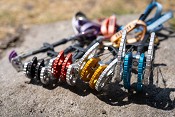
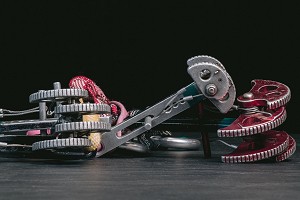

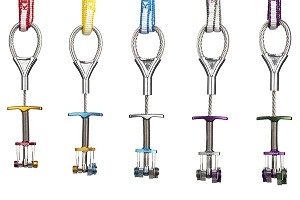
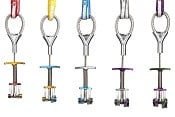
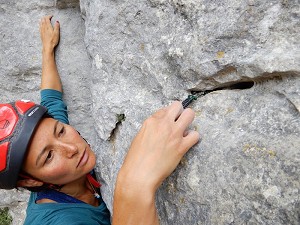
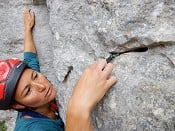
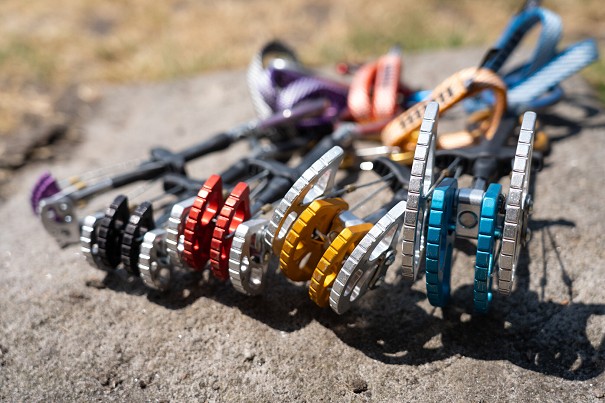
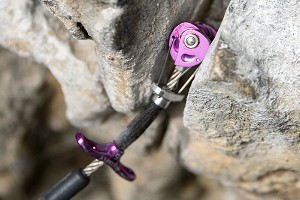


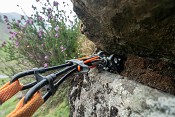
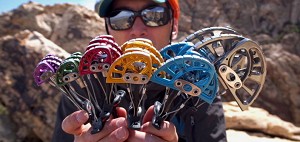

Comments
i understand the theory behind you saying you needed to extend with a quickdraw more often. But in practise you were already a camelot user....
so are you extending more than previous camalots?
OR are you assuming cams with extenders don't need a quickdraw?
Is there a third option? do you climb with another rack? do you find that dragons extend enough to not use a quickdraw?
these are honest questions, but I will admit to reading the article as if you were assuming this part as opposed to climbing routes multiple times with differing racks and actually making a quantitative statement. Apologies if i'm being overly pedantic
Our family rock is a set of (old) C4s and Dragons (both roughly from purple to blue). Smaller cams are a mixture if aliens, C3s, and Master cams (older model).
I don’t recall extending the C4s more than fiddling around the Dragon slings. Simply cause almost all the time if I need to extend a normal QD is not enough and then even the a Dragon would require and extender.
granted as per the review the new C4 has even shorter sling. Now would this make a difference, I can’t comment.
Hi Dave,
No, the sling is slightly shorter but basically if you need a quick draw for the name c4s youd need it for the old as well. The quick draw comment was in comparison to extendable sling cams like the dragons where extending the sling often means you dont require a quick draw. Personally I've never really liked the extendable slings as I find them very faffy, especially in winter when they can freeze.
I've been (mainly) using the C4 cams for about 15 years. I like the way they handle and I've never experienced them failing unless it was a really poor placement. However I'm a bit skeptical with the new stiffer stems. This may not just increase "walking" of cams, but it might also result in the gear popping out of shallow placements. A shorter loop is further increasing the forces from a dangling rope. A friend of mine had a very serious accident (using BD Ultralights) instead of the (older) normal C4s. Even though he was falling onto his gear many times before that and all! the cams held, on this occasion every single one of the Ultralights came out and resulted in him decking the floor. I was wondering whether the new cams have a stem that is equally rigid and might have the same implications.
The trigger keeper on the 5s & 6s is a superb addition when carrying multiple sets on long offwidths as it keeps things nice & compact & helps to avoid clutter. :)